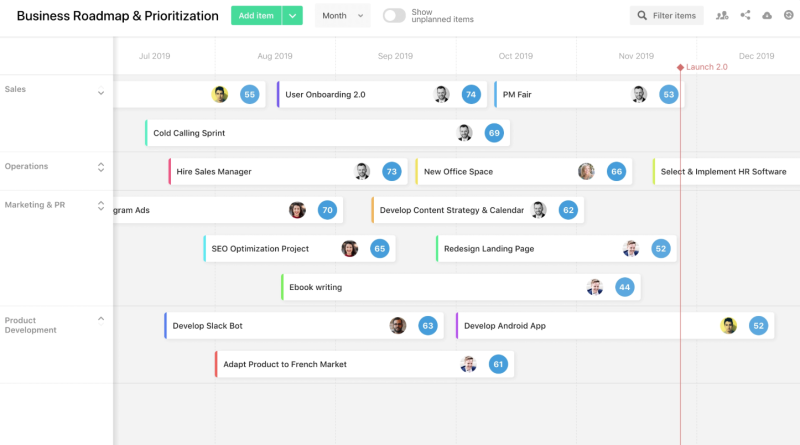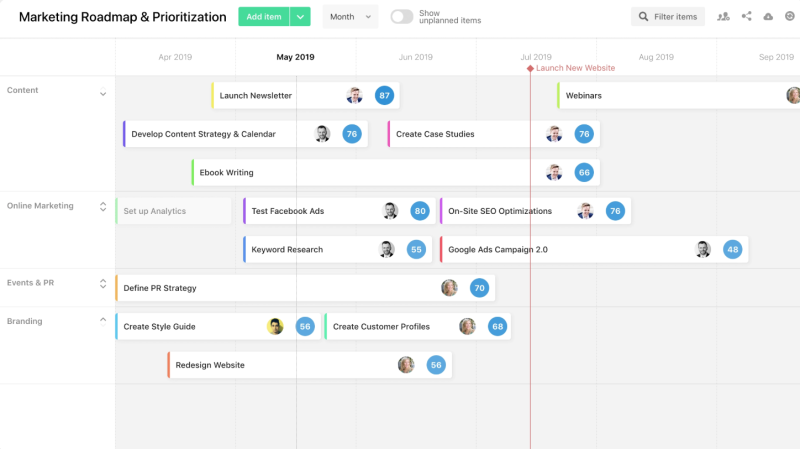Why you shouldn't be using excel for roadmap templates and 6 better alternatives

We’ve all heard of Excel, right? Everyone has heard of Excel. Although it might not be one of the “coolest” pieces of software on the market, no one can argue it’s one of the best.
Released by Microsoft in 1982 as Mutliplan, a popular Control Program for Microcomputers, the program initially did well before being outstripped by Lotus 1-2-3. Microsoft changed the name to Excel in 1987 and hasn’t looked back since. With the introduction of Macros in 1993 and all of the flexibility and options they provided, Excel became a staple in businesses worldwide.
Now, a staggering 1.1 billion people worldwide use Microsoft’s suite of productivity programs, which of course includes Excel, and office workers spend a third of their time using Excel specifically.
There’s a reason why Excel is so popular — it’s excellent at a lot of stuff! However, it’s often not the best tool for everything that a product manager needs to do. Despite this, many product managers use Excel for just about everything, even though there are better options.
Here we’ll take a look at what Excel is good for — and what it’s not so good for when it comes to product management.
What do product managers use Excel for?

There are a ton of great ways that product managers can use Excel to help in their daily workflow. A few that stand out to us include:
These are all great ways that product managers can use Excel and will significantly help streamline their day-to-day operations and output. There are also plenty of templates for these types of spreadsheets available. So, if you’re not already using Excel for these tasks, get on it!
That said, Excel isn’t the best tool for every product management task or problem you’ll encounter. Due to its familiarity and ubiquity, many product managers still use Excel for product roadmaps. We’re here to tell you to stop doing that!
Roadmaps are flexible, organic documents that need to change and be updated constantly. For all it’s good at, Excel can be a real pain to edit. And it can be incredibly time-consuming, slowing you down when you need to stay agile.
Sharing Excel sheets is notoriously tricky, too, leading to miscommunications, frustration, and just an overall drop in the tempo of your project. And to top it all off — Excel spreadsheets are kind of ugly! There, we said it.
Luckily for you, there are better options out there. Let’s look at what we think you should be using instead.
Product roadmap alternatives
Product roadmaps
A product timeline template can help you to visualize and monitor a product’s progress against expectations. It allows you to keep an eye on your schedule, where you risk slipping behind, and who is responsible for making up that time.
Missing a deadline or release date can be devastating for your product and lead to lost revenue, lost customers, and negative brand perception. By employing a dedicated product timeline, you can ensure that important milestones don’t get lost in the weeds and missed.
This method also allows for a more adaptable and customizable approach than a spreadsheet. By having a living document that is easy to edit on the fly when things change, and you fall behind, or heaven forbid, actually pull ahead of schedule, you can constantly monitor and optimize your approach to ensure you hit your release date.
Project roadmaps
Taking a step back from the nitty-gritty of product-specific roadmaps, we have project roadmaps.
A project roadmap template can give you a higher-level view of your project and product development as a whole. It allows you to focus on strategic goals, planning, and timeframes. This template can be shared with, and used by all levels of the team and can be constantly updated to reflect changes and problems, keeping everyone informed.
By clearly outlining the goals, dependencies, main deliverables, and potential risks of a project, you can keep all collaborators pulling in the same direction by giving them a thorough understanding of the project goals.
As well as providing the team with an overview of the high-level plans of a project, this type of template allows everyone to pay special attention to specific components of a project as they may relate to them. This empowers the team to estimate the time spent on each aspect of the project more precisely.
Unlike an Excel spreadsheet, a project roadmap can be adjusted and shared easily with every part of the project team as goals, plans, and timelines change. This allows for a greater alignment across the team and ensures the project's direction doesn’t stray too far off track.
When employing a project roadmap template, here are a few things to bear in mind:
Prioritize what tasks/items and projects/opportunities should make it to your roadmap
Set realistic goals
Specify the contact responsible for every task, stage, and substage
Keep it simple!
Business roadmaps

Let’s take another step back.
A business roadmap template gives you a clear and effective way to communicate your business's vision, goals, and plans. Mapping your goals and how you will achieve them not only aligns your entire business and keeps them moving in the right direction, but it also allows you to transform abstract concepts into actionable goals.
It is far better to say, “This year, we aim to achieve X% growth by taking the following steps…” than it is to say, “This year, we want to become the biggest llama food company in southern Arizona!”
One is a measurable goal with a clear roadmap. The other is a pipe dream with no clear direction or strategy.
An effective business roadmap sets clear goals, timelines, and actions. It also allows you to maintain an ever-changing template for the company direction that shows the team where the priorities and focus will be in the next few days, weeks, months, and years.
Business roadmap templates also cater to all departments throughout the company, from marketing to management and stakeholders to product development. Gone are the days of messy spreadsheets with scores of different tabs and sheets. Instead, all of the info can be condensed into an easy-to-share, easy-to-edit document across all sectors of your business.
Technology roadmaps
These days most businesses are powered by technology, and effective use of new technologies is one of the best ways to accelerate growth and meet your goals.
Using a technology roadmap template, you can plan and communicate your organization's high-level technology initiatives. It gives an overview of your current technology solutions, what may be valuable in the future that you’re not using right now, and which technologies are nearing the end of their lifecycles within your business.
Having all of your technology solutions laid out in one place allows you to see what is working well and what needs to be optimized. You can see the full spectrum of technology use across your company and identify pain points in different departments, allowing you to implement solutions.
The use of an in-depth technology roadmap template comes with myriad benefits, including:
Addressing any IT issues currently affecting your project
Removing any outdated or unnecessary applications and technologies to help cut costs
Increasing productivity by upgrading technology and serving the project’s immediate needs
Forming a clear picture of the technological infrastructure
Identifying and resolving conflicts regarding business priorities
Improving cybersecurity and overall IT
Avoiding a potential system failure by finding weaknesses in the IT infrastructure
When creating a technology roadmap, keep it simple and concise so it can be understood and interpreted across all levels of your organization. Avoid using technical jargon and focus on the benefits each piece of technological innovation will bring to your workflow.
Excel spreadsheets may be good for presenting large amounts of data, but they’re not great for communicating the reasoning behind the data. With a better solution like a technology roadmap template, you can present the data and the whys behind your use of technology, both now and in the future.
Marketing roadmaps

It’s no good creating a product if you don’t have anyone to sell it to. This is where your marketing strategy comes in — identifying customers, engaging them, and marketing your product to them. Hopefully, your efforts will result in lots of sales of your shiny new product!
An outcome-based template can greatly facilitate every step of your marketing strategy. This type of roadmap helps to outline all potential scenarios for a product. By defining your product's targets and use cases, you stand a much better chance of actually hitting those targets.
After all, hitting a target is hard when you don’t know what you’re aiming for!
Using an outcome-based template also allows you to collaborate and align with stakeholders to define two of the most important things about your product — what and why.
Excel spreadsheets can be incredibly difficult to share and work on as a team, especially if you are working in different locations or time zones. An outcome-based template is much easier to pass between team members and work on together. This allows for seamless integration between all levels, from stakeholders to engineers.
This form of roadmap also gives a clear purpose to your product and helps to orient it in the real world against your target customers. This way, not only do you know what you’re making but also why you’re making it the way that you are and who you’re making it for.
This keeps development focused on the end user and solving their needs and problems instead of your product becoming lost in abstracts and theoreticals.
Agile roadmaps
As the name implies, this type of roadmap is all about being agile, flexible, and adaptable. Instead of focusing on specific deadlines and timelines, an agile roadmap template can be used to measure progress over a shorter time.
Typically, you want to focus on a period of 2 - 4 months with this kind of roadmap rather than on long-term goals and objectives. After all, agile working is all about sprints, not marathons!
This approach can be hugely beneficial if you are operating in a very changeable market. If the market drastically changes in the next few months, there’s no point in having goals and strategies for the next few years. Staying agile in the face of uncertainty is a must.
However, timeline estimates are still key to any product development project, even super agile ones. The strength of using an agile roadmap is that it lets your team and stakeholders know when you will reach certain milestones and objectives.
This approach also allows you to set dynamic, progress-based goals that can be constantly updated in line with your actual output, as opposed to rigidly defined long-term milestones.
Using Excel for a roadmap like this can be a real chore due to the difficulty of updating and editing spreadsheets. When the goal is agility and flexibility, something like Excel can really hamper your progress and set things back with time-consuming busy work.
Your roadmap to success
Hopefully, we’ve convinced you to ditch Excel (not completely, mind you!) when it comes to creating project roadmaps for your business.
At airfocus, we have countless templates available for any roadmap you might need. All of our templates employ a powerful prioritization framework, seamlessly integrate with your current workflow, and are fully customizable.
Get in touch today to find out how you can start to streamline and optimize your product roadmaps!

Tomas Prochazka

Read also



Build great roadmaps

Experience the new way of doing product management




